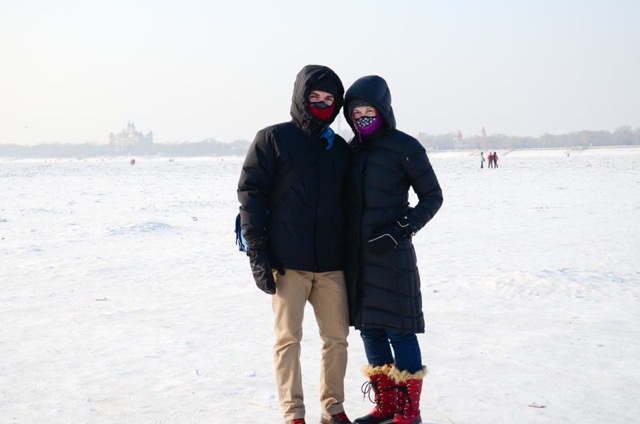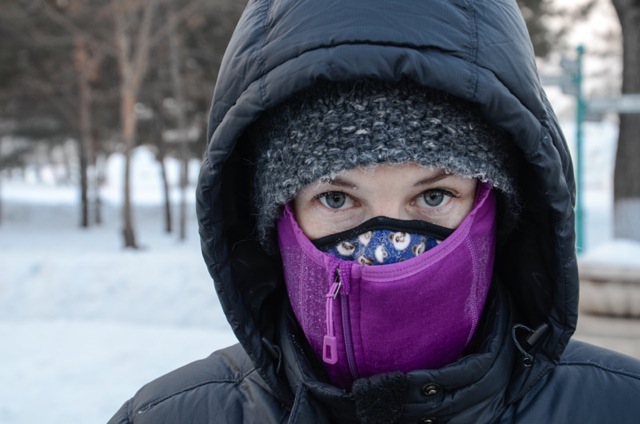So what exactly should you pack? Here is a handy list of the items we found useful on our trip.
Packing List for 3 Days in Harbin
2-3 wool/silk/polyester long sleeve shirts
2-3 pairs of wool/silk/polyester long underwear or tights1 pair of fleece pants
2 wool/fleece/down shirts (preferably with a hood and thumb holes)
1 pair of wind resistant pants (preferably insulated snow pants)
3 pairs of thin wool or synthetic wicking socks
3 pairs of thick wool socks
1 wind and water resistant jacket (preferably with a hood)
1 hat
1 pair of thin or liner gloves
1 pair of heavy gloves or mittens
1 pair of boots
2 face masks (2.5 PM compatible)
Disposable hand warmers
Why do we suggest the items above? Our research taught us that wearing the correct type of clothing can allow you to wear less items while staying warmer. The important thing to understand is the purpose of each layer.
Base Layer
Your base layer is the clothing closest to your body (after your undergarments that is). Because of this, you want to look for clothing that will keep you warm while being comfortable and wicking away moisture. Most people don't realize how much they sweat when bundled up under multiple layers and your base layer is used to regulate this. If you wear something like cotton, which does not wick away moisture, you may end up feeling much colder as your clothing will remain damp after you sweat. There is nothing enjoyable about cold, wet clothing. Instead opt for a base layer made of wool, silk, or polyester. These fabrics are soft on your skin and will keep you warm and dry. Plan to wear one long sleeve shirt and one pair of pants (long underwear/tights/etc) per day.
Insulating Layer
Over your base layer, comes the insulating layer of clothing which keeps you warm by trapping air close to your body. Wool, down, and fleece are all good choices for this layer. Most days, I wore one fleece and was more than warm enough. When temperatures dipped down in the evening, I added a second fleece for extra warmth. On my legs, I wore a pair of fleece pants. Mine happened to also be wind resistant which meant I only had to wear two layers on my legs most of the time.
Matthew and I asked for the Patagonia R1 hoodies for Christmas. I don't want to sound like an advertisement for Patagonia, but these were a lifesaver for us. They have a built in balaclava style hood which covers most of your face when zipped fully. They also have thumb holes to help keep your wrists warm. We would put on a pair of liner gloves, then use the thumb hole to keep our shirts pulled up, allowing us to limit the amount of skin that was exposed.
Outer Layer
The shell or outer layer protects you from wind, rain or snow and can add warmth if lined. You want to look for items that are either waterproof or water resistant but still allow breathability. Many ski jackets come lined with a fleece layer, allowing you to skip the insulating layer on warmer days if you choose. I would highly recommend a jacket with a hood on it.
Footwear
This is going to be controversial to some people, but do not wear more than two pairs of socks. Others who went to Harbin told me to wear 5 or 6 pairs but frankly, that's insane. Not only would my boots not fit, my feet would overheat and become sweaty. I wore a thin pair of wool socks under a thicker pair for our entire trip. I only had an issue when my feet became too hot inside a restaurant and started to sweat. Once my feet were wet, it was hard to keep my toes warm outside. Two pairs of proper socks and a pair of good boots is enough to keep your feet feeling fine.
We brought along disposable hand warmers and found them quite useful. Most of the time, correctly layering was able to keep us warm. However, our bulky gloves made it hard to take photos, handle money, or zip jacket pockets. We were forced to remove our thick gloves more often than we wanted and were glad to use the hand warmers to help defrost our fingers. This is also why I would recommend a thinner pair of gloves for under or inside your thicker pair.
You may have noticed I also mentioned bringing face masks. The pollution in Harbin is bad and air quality was poor at various points throughout our trip. The face mask ensured that we were safe to be outside and had the added bonus of keeping our faces warm. I'd recommend two masks as ours often became wet (and icy) from our breath. Alternating between two will allow for the other mask to dry out between wears.
I hope this list helps you plan what to pack for Harbin or other cold climates. With a little research, you can spend your time thinking about ice castles and not your frozen toes.





Such a great list :)
ReplyDeleteThat is a really great list, thanks for sharing it.
ReplyDeleteWow, what a great list!
ReplyDeleteIt should be very cold, if I want to go travelling, I should be prepared a lot for it
ReplyDelete